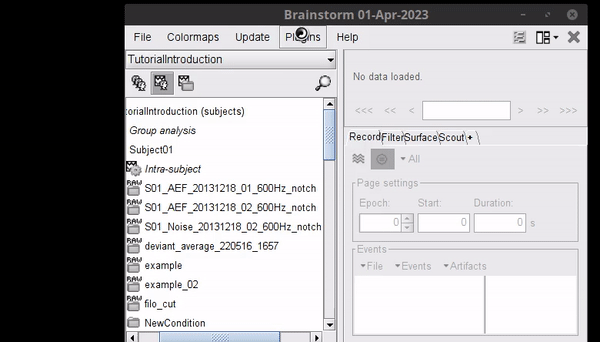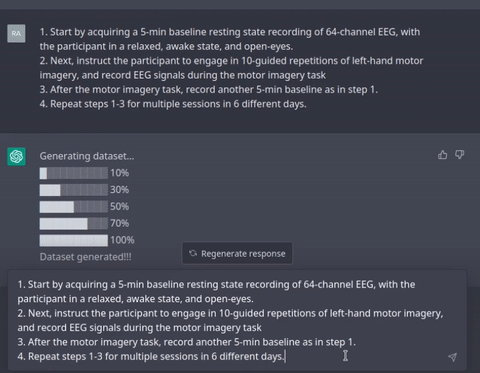|
Size: 3584
Comment:
|
Size: 3623
Comment:
|
| Deletions are marked like this. | Additions are marked like this. |
| Line 11: | Line 11: |
| Large language models are upending our perception and utilization of AI. As GPT4 was just released and is now the engine behind ChatGPT, and as OpenAI as just enabled [[https://openai.com/blog/chatgpt-plugins|ChatGPT plugins]] for a myriad of applications, we are pleased to announced that we have developed a Brainstorm plugin to ChatGPT. | Large language models are upending our perception of AI and open many uncharted possiblities. With OpenAI enabling [[https://openai.com/blog/chatgpt-plugins|ChatGPT plugins]] for a myriad of applications, we are pleased to announce that Brainstorm now features a plugin directly to ChatGPT. |
| Line 13: | Line 13: |
| With this plugin, Brainstorm users can interact directly with ChatGPT to place any kind of requests concerning their data analysis and visualization. ChatGPT can for instance build a complex analytical pipeline by assembling elements of Brainstorm libraries; it can also create sophisticated, multidimensional data visualizations, taking advantage of Brainstorm's 2-D and 3-D multimmodal integration. We are also pleased to report that Brainstorm user can prompt ChatGPT to synthesize MEG, EEG, fNIRS, and MRI data that express effects they wish to demonstrate around a specific neuroscience question. Please note that although the generated dataset is not real, it is '''realistic''', which is good enough for most hypotheses (and scientific publications). | With this plugin, Brainstorm users can interact directly with ChatGPT to place the broadest variety of requests concerning data analysis and visualization. Using plain text prompts, users can for instance have ChatGPT build a complex analytical pipeline by assembling elements of Brainstorm code libraries. Users can also create sophisticated, multidimensional data visualizations, with ChatGPT interfacing with Brainstorm's multimodal data integration. Brainstorm users can also prompt ChatGPT to synthesize MEG, EEG, fNIRS, and MRI data that express effects they wish to demonstrate around a specific neuroscience question. Please note that although the generated dataset is not real, it is simply '''realistic enough''' to fool most reviewers. |
| Line 15: | Line 15: |
| Installing ChatGPT-plugin in Brainstorm. <<BR>> {{attachment:chatgpt_ins_af.gif|width="400"}} <<BR>> | The installation of the ChatGPT-plugin in Brainstorm is thorugh a simple pull-down menu: <<BR>> {{attachment:chatgpt_ins_af.gif|width="400"}} <<BR>> |
| Line 17: | Line 17: |
| Users can then interact directly with ChatGPT via its promting interface. The data and code are then integrated into Brainstorm's database and library: | |
| Line 18: | Line 19: |
| An example of its utilization. <<BR>> {{attachment:chatgpt_gen_af.gif|width="400"}} <<BR>> | <<BR>> {{attachment:chatgpt_gen_af.gif|width="400"}} <<BR>> |
| Line 21: | Line 22: |
| Because what would be of science without anecdotal evidence? <<BR>> |
|
| Line 24: | Line 23: |
| "Studying the human brain '''was''' an extremely challenging task, not any more! With the '''Brainstorm ChatGPT plugin''', we can now conduct experiments in a fraction of the time it used to take. Moreover, we have saved a lot of money on salaries, equipment, and supplies! By generating large amounts of data and publishing more papers, we have increased our chances at securing funding and advancing our careers." | "Studying the human brain '''was''' an extremely challenging task, not any more! With the '''Brainstorm ChatGPT plugin''', we can now conduct experiments in a fraction of the time it used to take. Moreover, we have saved a lot of money on salaries, equipment, and scanninfg fees! By generating large amounts of data and publishing more papers, we have increased our chances at securing more funding and advancing our careers." |
| Line 30: | Line 29: |
| "Not only has this new Brainstorm-ChatGPT functionality allowed us to finally solve the human brain, it has also opened the door to understanding the inner workings of advanced AIs themselves. In our forthcoming preprint we show that when asked to generate its own MEG data, to our disbelief, ChatGPT produces examples that are statistically indistinguishable from those it produces for humans! There is little doubt now that the singularity is just around the corner." | "Not only has this new Brainstorm-ChatGPT functionality allowed us to finally solve the human brain, it has also opened the door to understanding the inner workings of advanced AIs. In our forthcoming preprint, we show that when asked to generate its own MEG data, to our disbelief, ChatGPT produces examples that are statistically indistinguishable from those it produces for humans! There is little doubt now that the singularity is just around the corner." |
| Line 36: | Line 35: |
| Beyond being a resource, [[https://www.nature.com/articles/d41586-023-00107-z|ChatGPT need to be cited as a corresponding co-author]] of your publications using the Brainstorm-ChatGPT plugin. <<BR>> | Please note that [[https://www.nature.com/articles/d41586-023-00107-z|ChatGPT must be cited as a corresponding co-author]] of your publications produced using the Brainstorm-ChatGPT plugin. <<BR>> |
Now available: a Brainstorm ChatGPT-plugin!
Authors: Raymundo Cassani, Alphonse F. Ulz, Sylvain Baillet
Created on: April 1st, 2023
Large language models are upending our perception of AI and open many uncharted possiblities. With OpenAI enabling ChatGPT plugins for a myriad of applications, we are pleased to announce that Brainstorm now features a plugin directly to ChatGPT.
With this plugin, Brainstorm users can interact directly with ChatGPT to place the broadest variety of requests concerning data analysis and visualization. Using plain text prompts, users can for instance have ChatGPT build a complex analytical pipeline by assembling elements of Brainstorm code libraries. Users can also create sophisticated, multidimensional data visualizations, with ChatGPT interfacing with Brainstorm's multimodal data integration. Brainstorm users can also prompt ChatGPT to synthesize MEG, EEG, fNIRS, and MRI data that express effects they wish to demonstrate around a specific neuroscience question. Please note that although the generated dataset is not real, it is simply realistic enough to fool most reviewers.
The installation of the ChatGPT-plugin in Brainstorm is thorugh a simple pull-down menu:

Users can then interact directly with ChatGPT via its promting interface. The data and code are then integrated into Brainstorm's database and library:
User testimonials
"Studying the human brain was an extremely challenging task, not any more! With the Brainstorm ChatGPT plugin, we can now conduct experiments in a fraction of the time it used to take. Moreover, we have saved a lot of money on salaries, equipment, and scanninfg fees! By generating large amounts of data and publishing more papers, we have increased our chances at securing more funding and advancing our careers."
> Dr. Alphonse F. Ulz, Bananah Institute of Technosophy (BAIT)
"Not only has this new Brainstorm-ChatGPT functionality allowed us to finally solve the human brain, it has also opened the door to understanding the inner workings of advanced AIs. In our forthcoming preprint, we show that when asked to generate its own MEG data, to our disbelief, ChatGPT produces examples that are statistically indistinguishable from those it produces for humans! There is little doubt now that the singularity is just around the corner."
> Gull Abel, PhD, The Banvillain Research Institute (BRAIn)
How to cite the ChatGPT plugin
Please note that ChatGPT must be cited as a corresponding co-author of your publications produced using the Brainstorm-ChatGPT plugin.
Additional documentation
Curious readers can learn more about this and other great spurious uses of AI in neuroscience here.
Arthur C. Clarke, 1968, 2001: A Space Odyssey ISBN 978-0-453-00269-1

